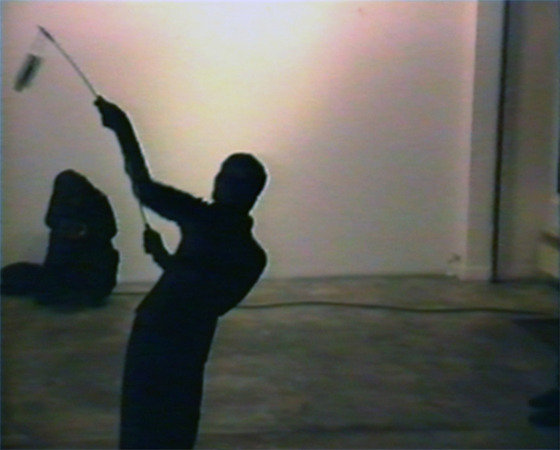Les Separes
dal 8/11/2012 al 5/1/2013
Segnalato da
Bruant & Spangaro
Cecile Dauchez
Koenraad Dedobbeleer
Claire Fontaine
Karl Holmqvist
Karl Holmqvist
David Lamelas
Toshio Matsumoto
Corin Sworn
Vincent Romagny
8/11/2012
Les Separes
CEAAC Centre Europeen d'Actions Artistiques Contemporaines, Strasbourg
Doppelganger 1/3. The three-exhibition doppelganger cycle brings together several possible versions of the phenomenon, hypotheses regarding its modes of formation and existence which cannot be imagined, deconstructed or induced.

Curated by Vincent Romagny
With Bruant & Spangaro, Cécile Dauchez, Koenraad Dedobbeleer, Claire Fontaine and Karl Holmqvist, Karl Holmqvist, David Lamelas, Toshio Matsumoto, Corin Sworn
In German, the term doppelgänger means "a double," while leaving a lingering doubt as to the figure's reality: the doppelgänger is identical, but does this mean it is separate? Moreover, there is no indication of how this second self is generated. It is not an outcome, an end in itself: it is a mode of production of the work of art, of our hidden lives, of the human world, perhaps. Endowed with an uncertain mythological dimension, the doppelgänger is fundamentally romantic and literary: the recommencing it involves has the particular characteristic, in relation to the classical notion of the double, of being internal. The interior aspect of the phenomenon of splitting leads the individual to consider himself as something other while remaining himself. Necessarily experienced privately, this dissociation effect is quite common, at least to a limited degree and sometimes to the point of breakdown. Thus the doppelgänger fluctuates between being a figure of destructuration and a universally shared structure.
As an almost personified process, the doppelgänger is the cause of the clashes making up our psyches, our subjectivity. The doppelgänger exists only in solitude, not in a fully achieved repetition, but, on the contrary, in an unfinished, impossible, endlessly postponed reiteration culminating in neither otherness nor sameness.
The three-exhibition doppelgänger cycle will bring together several possible versions of the phenomenon, hypotheses regarding its modes of formation and existence which cannot be imagined, deconstructed or induced. We must follow them, then, as if they were guides, picking up their written traces: for perhaps only the succession of sentences—time—can give an account of them. Thus the works will be an echo, a reflection of texts we shall try to follow for their ability to provide the clue—rather than the proof—to the existence of the doppelgänger in all his secret forms, the first being the separation: Pasolini's unfinished novel Petrolio.
This ultimate work is at once mythological—"My story is not a story but a parable"; aesthetic and political; literary and cinematic novelistic and critical—he had decided "not to write a story, but to construct a form," closer to poetry than to any strictly novelistic form. To achieve his purposes, Pasolini resorts to dividing his hero, Carlo, in two. A crucial "disorder" factor, this binary separation is followed by a host of similar occurrences, among them several changes of sex by one of the two characters. Clearly, then, the doppelgänger is not a matter of temporal recall, of copying, of the game of the return of forms. It is not an outcome, an end in itself; it is a mode of production of the work of art whose existential, experiential aspect is constantly reasserted.
Echoing as well Antonin Artaud's famous declaration "I am separate," the exhibition Les Séparés will set out to evoke the figure of the subject and of a possible originary duality often experienced as a rending and as a factor for disturbance as well as for novelising: a double born of a scission, incompletely other. A movement the work records or transmits, even as it is permeated by it.
The works making up the Les Séparés exhibition are, like Claire Fontaine and Karl Holmqvist's neon piece Untitled (The Weeping Wall inside us All), which will be present in all three exhibitions, are the clue, the narrative, the account, the still-palpable effect of this movement. Whether images of the very act of separation (Cécile Dauchez), of possible mental or psychological structures (Koenraad Dedobbeleer, David Lamelas), or of effects of this primordial separation (Bruant & Spangaro, Corin Sworn, Toshio Matsumoto), the works have in common neither medium nor subject, but rather a paradoxical structure: an endlessly ongoing separation that no suturing can draw together, yet which will never become final.
The CEAAC is funded by Région Alsace, Conseil Général du Bas-Rhin, Ville de Strasbourg and DRAC Alsace. Thanks to Fluxus Fund, London.
Press contact:
Debora Fischkandl Tel. +33 (0)3 88256970 communication@ceaac.org
CEAAC
7, rue de l'Abreuvoir Strasbourg



